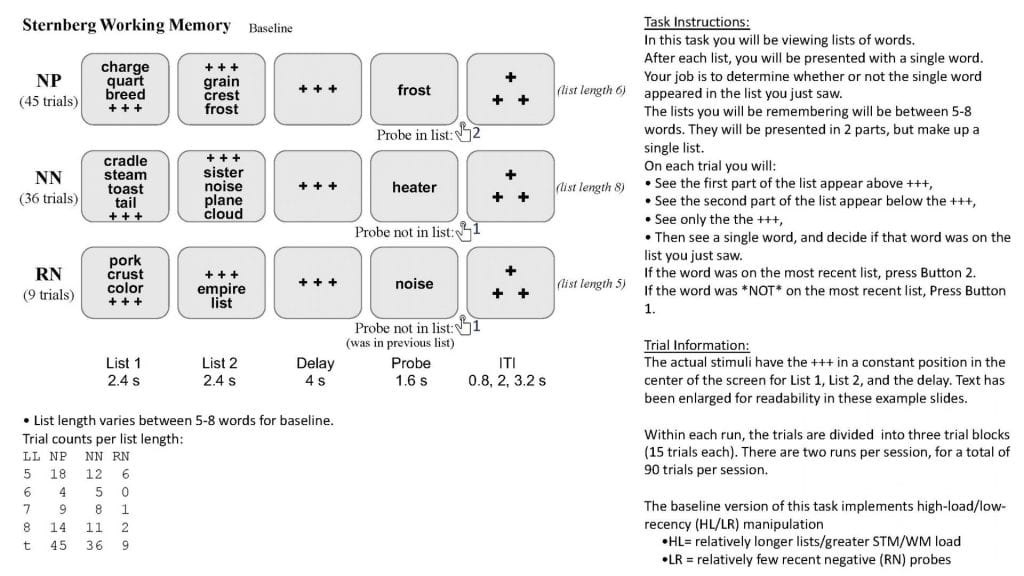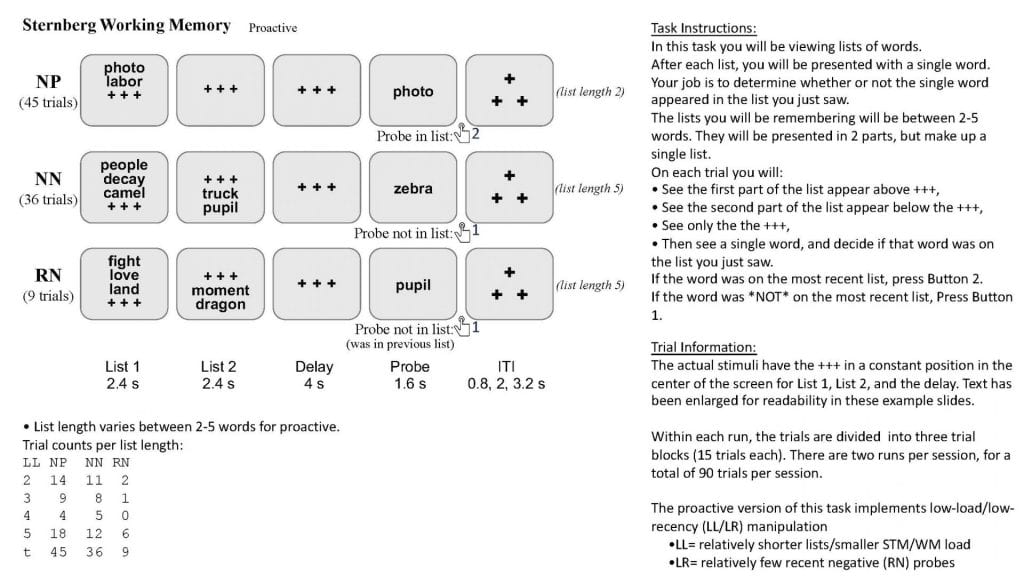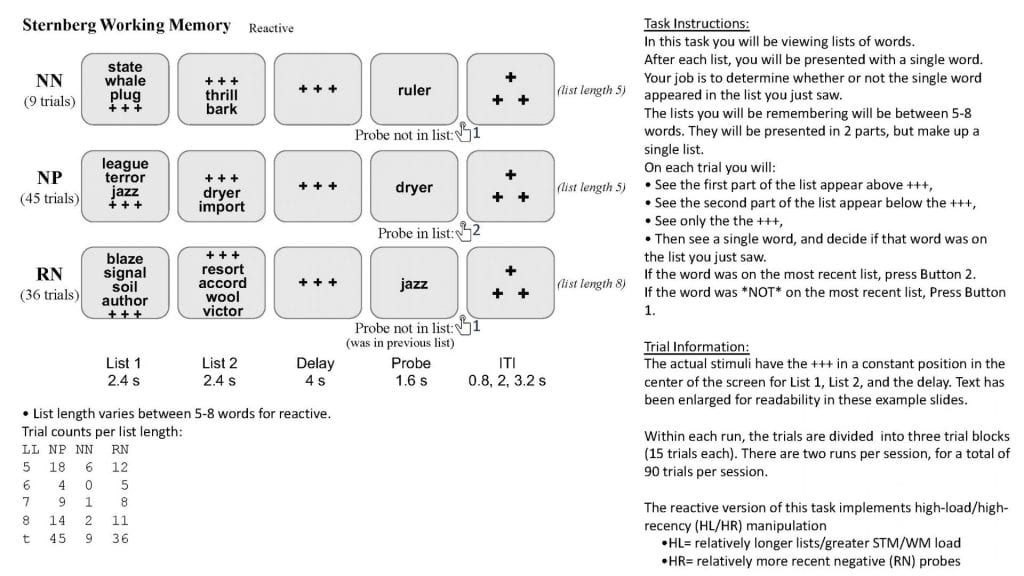The Sternberg item-recognition task is a widely used paradigm for studying short-term / working memory (STM/WM) in experimental psychology and neuroscience, and the involvement of cognitive control processes. The key variable in the task is the list length manipulation of the memory set of items, which are encoded during the first phase of the trial and then retained over a short (seconds long) retention interval, in order to respond appropriately to a final probe item. Probe judgments indicate whether the item is positive (was a member of the current trial memory set) or negative (not a member of the memory set). As the list length increases, probe judgments become less accurate and slower, indicating increases in STM/WM demands.
A more recent Sternberg variant is often referred to as the Recent Probes (Jonides & Nee, 2006). In this variant, the key manipulation is whether the probe is a recent negative or novel negative. Recent negative probes are ones in which the probe item was not a member of the current trial memory set, but was a member of the memory set in the previous trial. Consequently, there is a high degree of familiarity to the probe, which produces increased interference (slower RTs and increased errors).
Most theoretical frameworks assume that when presented with only a small number (1-4) of items, participants will rely primarily on STM/WM processes that actively maintain information over the retention interval to guide probe judgments. In contrast, when a large number of items (e.g., 7 or greater) need to be stored, STM/WM capacity may be exceeded and participants will start to rely more on retrieval-focused strategies cued by probe presentation. In the DMC framework, the primary assumption is that the expectation of a low STM/WM load should increase the tendency to utilize proactive control, in which memory set items are encoded and maintained in a way that can successfully bias attention towards the probe item, in advance of its onset.
A memory set list-length manipulation can induce STM/WM load expectancies. When most of the trials in a condition have small memory sets, this condition is referred to as having a Low-Load (LL) expectancy. The key feature of this manipulation is to dissociate the load expectancy from the experienced load. Here, the primary comparison is on critical trials, which are matched in terms of list-length across conditions, but differ in terms of load expectancy (LL vs. HL). Speer et al (2003) tested this manipulation, finding that behavioral performance and brain activity dynamics significantly differed for 6-item lists presented in the context of conditions with LL or HL expectancy (e.g., faster and more accurate responses observed under LL expectancy).
A second type of expectancy manipulation is for recency-related interference. Conditions in which negative probe trials are associated with a High-Recency expectancy (HR) should increase reactive control, particularly when this also occurs under high-load conditions (HL/HR). Under such conditions, reactive control may be the most effective, utilizing the activation of a probe-triggered familiarity signal to more carefully evaluate memory set items maintained in STM/WM. In Burgess & Braver (2010), support was found for HR expectancy in modulating cognitive control strategy (however, this occurred under LL conditions, so effects were associated with a shift towards proactive control).
Below is relevant information regarding the available task-variants and conditions, in terms of the relevant procedures and parameters.
Web-based Behavioral Task Scripts
This version includes baseline, proactive, and reactive conditions of the Sternberg item-recognition STM/WM task, coded for web-based administration. This version uses English words selected for optimized lexical properties using the The English Lexicon Project (e.g., word length, frequency) as stimuli (and with lexical properties equated across condition); responses are made manually.
Request access to the behavioral task scripts and associated stimuli lists
Baseline
This condition implements a high-load, low-recency (HL/LR) manipulation. There are 4 different memory set list-lengths (5, 6, 7 and 8 items). The proportions are biased to create both HL expectancy and also sufficient trial numbers of the critical 5-item lists (5-item: 40%, 6-item: 10%, 7-item: 20%, 8-item: 30%). Thus, the expected STM/WM load is 6.4 items. The encoding period is divided into 2 presentation screens, with the first presenting 3-4 items, and the second presenting 2-4 items (total encoding period is 4 sec). Critical 5-item trials always have 3 items on the first screen, 2 items on the second screen. This produces uncertainty regarding the trial list length during the first phase of encoding. The retention interval is 4 seconds. Half of the items are positive probes and half of the items are negative probes. All positive probes are novel (NP), meaning that they have not appeared in any prior trial. On novel negative (NN) probe trials, the probe item was not presented on any prior trial. On recent negative (RN) probe trials, the probe item was a member of the prior trial (but not the current trial) memory set. The negative probe proportions are biased to produce the LR expectancy (80% NN, 20% RN). All positive probes are also novel (NP), meaning that they have not appeared in any prior trial. The full condition includes 120 trials (with 24 NP, 16 NN, and 8 RN of the critical 5-item trials).
Proactive
This condition implements a LL/LR manipulation. There are 4 different memory set list-lengths (5, 4, 3 and 2 items). The proportions are biased to create both LL expectancy and also sufficient trial numbers of the critical 5-item lists (5-item: 40%, 4-item: 10%, 3-item: 20%, 2-item: 30%). Thus, the expected STM/WM load equal to 3.6 items. The encoding period is divided into 2 presentation screens, with the first presenting 2-3 items, and the second presenting 0-2 items. Critical 5-item trials always have 3 items on the first screen, 2 items on the second screen, and so are exactly matched to the baseline condition. Encoding and retention durations are also matched to baseline. Probe items are matched in positive/negative and recency proportions to the baseline condition. The full condition includes 120 trials (with 24 NP, 16 NN, and 8 RN of the critical 5-item trials).
Reactive
This condition implements a HL/HR manipulation. List-lengths and proportions are matched to the baseline condition, with the expected STM/WM load equal to 6.4 items. Encoding and retention parameters are matched to baseline. Probe items are half positive, half negative. Positive probes are always novel (NP), meaning that they have not appeared in any prior trial. Negative probe proportions are biased to produce the HR expectancy (20% NN, 80% RN). The full condition includes 120 trials (with 24 NP, 8 NN, and 16 RN of the critical 5-item trials).
fMRI Task Scripts
This version includes baseline, proactive, and reactive conditions of the Sternberg item-recognition STM/WM task, coded for Eprime. It assumes manual responses coming in through a fiber-optic port. All conditions are implemented in a mixed block/event-related design. Within each scanning run, 3 task blocks alternate with 4 resting fixation blocks (30 sec duration); in each task block, the inter-trial interval randomly varies (across 3 step sizes).
Request access to the fMRI task scripts
Baseline
The same conditions and trial type frequencies are used as the behavioral version. Likewise the same trial timing parameters are used. The complete condition consists of 2 scanning runs, for a total of 90 trials, including 18 NP, 12 NN and 6 RN of the critical 5-item trials.
Proactive
The same conditions and trial type frequencies are used as the behavioral version. The complete condition consists of 2 scanning runs, for a total of 90 trials, including 18 NP, 12 NN and 6 RN of the critical 5-item trials.
Reactive
The same conditions and trial type frequencies are used as the behavioral version. The complete condition consists of 2 scanning runs, for a total of 90 trials, including 18 NP, 6 NN and 12 RN of the critical 5-item trials.
In addition to standard behavioral measures of RT and accuracy (e.g., collapsing across trial type), there are a number of measures that are specific to this task, which are described below. Additionally, it can be useful to calculate the internal consistency (as split-half reliability, Cronbach’s alpha, or ICC) for various measures, particularly if you plan to use these to investigate individual differences.
Critical Trial Performance
This computes behavioral performance specifically on the 5-item list-length trials that are matched across conditions. Performance is computed on each of the 3 probe types: NP, NN and RN. In addition to analyzing accuracy and RT data separately, these data are also combined to produce composite scores, both in terms of an inverse efficiency score (IES; computed as RT/accuracy), and also by summing the two measures (RT/error rate) after they a z-score normalized (ZSUM). The DMC framework predicts that performance will be better (faster, more accurate) on NP trials in the proactive relative to the baseline condition.
Recency Effect
This computes the magnitude of behavioral interference measured as RN – NN performance. It can be computed on RT and accuracy, and also on the composite RT/accuracy measures (IES; ZSUM). The DMC framework predicts a reduction in the recency effect magnitude in the reactive control condition relative to the baseline condition.


